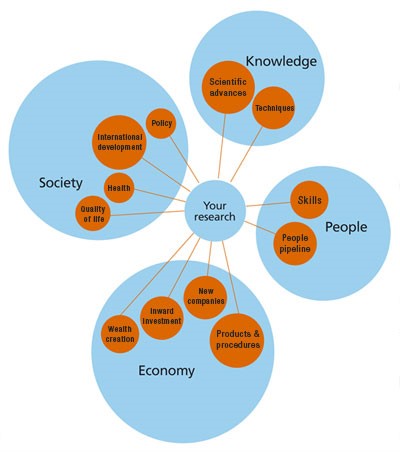EPSRC Impact Acceleration Account (IAA) 2022-2025
The Engineering and Physical Sciences Research Council (EPSRC) has awarded the University a £1.2m Impact Acceleration Account 2022-2025, which is a block grant to accelerate the impact of research.
Call now open. See March 2024 Open IAA Call.
Previous calls
As part of the EPSRC IAA 2022-2025 programme, we ran an open call in May 2022 entitled “Immediate Impact” to take advantage of new and existing partnerships that were ready to apply for funding and make progress along the impact pathway.
This was followed by another open call in November 2022 entitled "Immediate Impact 2" and an interdisciplinary call across both AHRC and EPSRC remits in October 2023.
The deadline for all IAA submissions is currently closed.
Though subject to change, you can get a sense of the application process by reviewing the guidance and application forms below.
EPSRC IAA Application Form November 2022
EPSRC IAA Guidance November 2022
For queries please contact Mark Bowen (m.bowen1@lancaster.ac.uk) and Jamie Hodge (j.p.hodge@lancaster.ac.uk)

What is an Impact Acceleration Account (IAA)?
IAAs are strategic awards provided to institutions to support knowledge exchange (KE) and impact from their EPSRC funded research. IAAs allow Research Organisations to respond to opportunities in flexible, responsive and creative ways, aligned to their institutional strategies and opportunities. Responsibility for management of IAAs is devolved to the institution to operate tailored schemes to facilitate the realisation of impact. The awards are intended to add value to existing funding and take advantage of new or unforeseen opportunities. IAAs are one of the funding mechanisms for supporting knowledge exchange, innovation and impact at UK Research and Innovation.
EPSRC IAA Objectives
- Strengthening user engagement
- Strengthening the exchange of knowledge through culture change and capability development, including through the development of skills for KE activity
- Supporting knowledge exchange and commercialisation at early stages of progressing research outputs and outcomes to the point when they would be supported by other funding
- Supporting new, innovative and imaginative approaches to KE and Impact, including processes that enable “fast failure” and appropriate learning
- Supporting activities that enable impact to be achieved in an effective and timely manner, including secondments and people exchange
Pathways to Impact
Together with our research communities and partners, we want to encourage researchers to think about Pathways to Impact. Pathways to Impact offers a chance for researchers to delve deeper into looking at who is likely to benefit from their work, how to engage with them, and how to go about increasing the likelihood of this happening. Whilst UK Research and Innovation demands excellence as the main factor in deciding upon funding, Pathways to Impact is viewed as an added criterion, amongst others, for research applicants to show the potential value of their work.
A clearly thought through and acceptable pathways to impact is an essential component of a research proposal and a condition of funding. Applicants are required to use this section of the proposal to identify the potential impact of their work and to outline the steps they can sensibly make now to facilitate the realisation of those impacts.
Identified impacts should clearly align with the case made for the importance of the research but may be much broader. If a proposal is ranked high enough to be funded but does not have an acceptable Pathways to Impact it will be returned. Applicants will be asked to revise the Pathways to Impact and the proposal will only be funded once that acceptable revision has been received.
Why is impact important to EPSRC?
EPSRC helps contribute to the UK’s competitiveness and welfare through the support of an extensive range of research and postgraduate training, with a portfolio of approximately £3 billion. The intention now is to encourage researchers to look at how their work could achieve a positive impact and the pathways to bringing this to fruition. This is achieved through the inclusion of the Pathways to Impact section within the application process. ‘Impact’ itself is recognised as follows
- Academically - with regard to presenting an ascertainable contribution in academic progress in understanding methods, theory and application.
- Social & Economic - in terms of presenting an ascertainable contribution the research would make to the society and economy whether it be enhancing standard of living, economic performance or the effectiveness of public services.
These are just some indicative impact areas that could benefit through EPSRC IAA funded research:
- Knowledge – Scientific advances, Techniques
- People – Skills, People Pipeline
- Economy – Wealth creation, Inward investment, New companies, Products and Services
- Society – Quality of Life, Health, International development, Policy

Completing your Pathways to Impact section
Tips to bear in mind:
- Who could potentially benefit from this research? What are their needs? And how can they be specifically targeted and reached?
- Make the description regarding how potential beneficiaries will be impacted and involved as clear as possible. The use of performance milestones and analysis is advised.
- Will it be possible to involve potential recipients of the research? If so, how early can they be involved?
- Have there been any previous cases of impact generating activities or knowledge exchange that is relevant to this research?
- Ensure commitment towards accomplishing research impacts is shown throughout.
Try to avoid the following:
- Being vague, try to be as detailed and specific as possible.
- Not being project specific. Although we encourage being thorough, make sure that the information is relevant to the project itself.
- Placing too much onus on track record. Instead, look at will be accomplished as part of this research project.
- Focusing too narrow. Try to consider the broad range of people that could benefit from the project. Try not to keep activities too dissemination orientated or end motivated. Remember the key focus here is impact.

